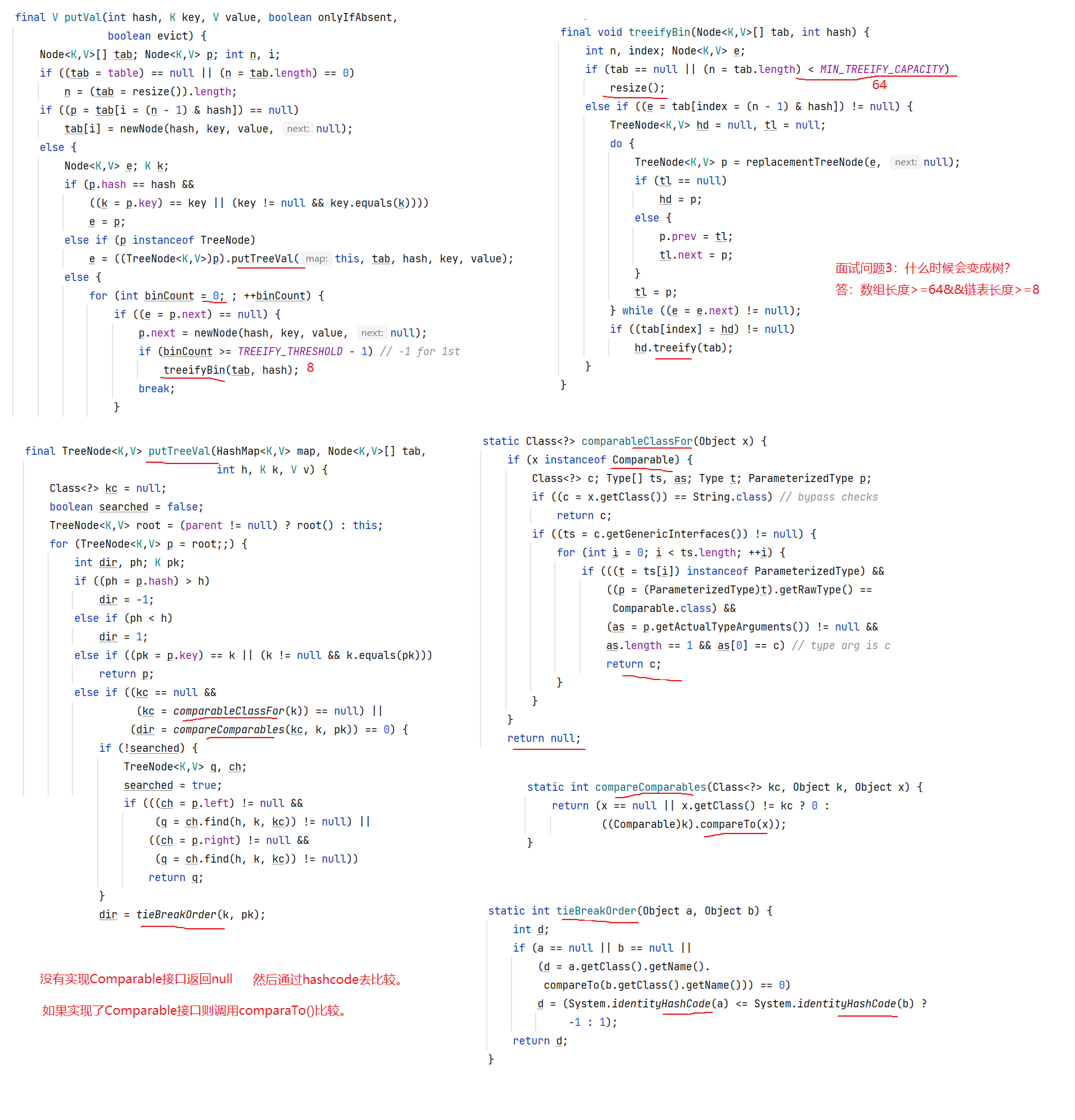力扣692. 前K个高频单词
https://leetcode.cn/problems/top-k-frequent-words/description/
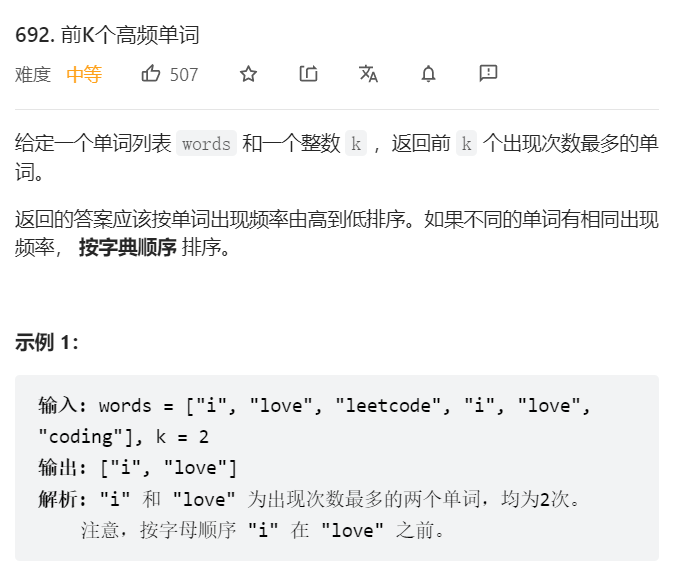
方法一:优先队列
思路:对于前k个最大或最小最容易联想到之前学过的topk问题,用优先级队列解决。(升序大根堆,降序小根堆)本题要求按频率从高到低排序,所以采用小根堆。
哈希表中存的键值对映射关系插入到小根堆中,
(这里需要注意:要自己创建一个比较器Comparator,设置比较规则compare,规则是单词频率升序并且字母顺序降序)
如果小根堆的大小超过k个,就弹出堆顶元素(最小元素),这样小根堆中剩下的就是k个最大的。然后用一个list(String)接收这k个元素直到小根堆弹空为止,这时list中存的单词是按出现频率升序并且字母顺序降序排的,再逆置list即可。
//方法1:小根堆
class Solution {
public List<String> topKFrequent(String[] words, int k) {
HashMap<String,Integer> map=new HashMap<>();
//用一个哈希表记录每一个字符串出现的频率
for(int i=0;i<words.length;i++){
String str=words[i];
map.put(str,map.getOrDefault(str,0)+1);
}
//小堆里面存String降序,Integer升序,最后弹出堆顶就是符合题意的
PriorityQueue<Map.Entry<String,Integer>> pq=new PriorityQueue<Map.Entry<String,Integer>> (new Comparator<Map.Entry<String,Integer>>(){
public int compare(Map.Entry<String,Integer> entry1,Map.Entry<String,Integer> entry2){
return entry1.getValue()==entry2.getValue()?entry2.getKey().compareTo(entry1.getKey()):entry1.getValue()-entry2.getValue();
}
});
List<String> list=new ArrayList<>();
for(Map.Entry<String,Integer> entry:map.entrySet()){
pq.add(entry);
if(pq.size()>k){
pq.poll();
}
}
while(!pq.isEmpty()){
list.add(pq.poll().getKey());
}
Collections.reverse(list);
return list;
}
}
复杂度分析
时间复杂度:O(l×n+m×l×logk),其中 n表示给定字符串序列的长度,m 表示实际字符串种类数,l表示字符串的平均长度。我们需要 l ×n 的时间将字符串插入到哈希表中,以及每次插入元素到优先队列中都需要 l×logk 的时间,共需要插入 m次。
空间复杂度:O(l×(m+k)),其中 l 表示字符串的平均长度,m 表示实际字符串种类数。哈希表空间占用为 O(l×m),优先队列空间占用为 O(l×k)。
方法二:哈希表+排序
思路:利用哈希表记录每一个字符串出现的频率,然后将哈希表中所有字符串进行排序,排序时,如果单词频率相同,按字母升序排,单词频率不同,按单词频率降序排。
最后返回list中前k个字符串。
//方法2:排序
public List<String> topKFrequent(String[] words, int k) {
Map<String, Integer> cnt = new HashMap<String, Integer>();
for (String word : words) {
cnt.put(word, cnt.getOrDefault(word, 0) + 1);
}
List<String> rec = new ArrayList<String>();
for (Map.Entry<String, Integer> entry : cnt.entrySet()) {
rec.add(entry.getKey());
}
Collections.sort(rec, new Comparator<String>() {
public int compare(String word1, String word2) {
return cnt.get(word1) == cnt.get(word2) ? word1.compareTo(word2) : cnt.get(word2) - cnt.get(word1);
}
});
return rec.subList(0, k);
}
//匿名内部类,Map.Entry获取键值对
}
复杂度分析
时间复杂度:O(l×n+l×m×logm),其中 n 表示给定字符串序列的长度,l 表示字符串的平均长度,m 表示实际字符串种类数。我们需要 l×n 的时间将字符串插入到哈希表中,以及l×m×logm 的时间完成字符串比较(最坏情况下所有字符串出现频率都相同,我们需要将它们两两比较)。(mlogm用快排或归并按单词频率排,如果频率相同,内部嵌套循环根据字母顺序排)
空间复杂度:O(l×m),其中 l 表示字符串的平均长度,m 表示实际字符串种类数。哈希表和生成的排序数组空间占用均为 O(l×m)。
总结:方法一和方法二都是先把单词和它出现的频率保存到HashMap中,然后方法一用堆排序,方法二用Collections.sort()。排序中都需要要自己创建一个比较器Comparator,设置比较规则compare。
哈希表模拟实现
// key-value 模型
public class HashBucket {
private static class Node {
private int key;
private int value;
Node next;
public Node(int key, int value) {
this.key = key;
this.value = value;
}
}
//usedSize是数组+链表这个结构里面所有数据元素的个数
private Node[] array;
private int size; // 当前的数据个数
private static final double LOAD_FACTOR = 0.75;
private static final int DEFAULT_SIZE = 8;//默认桶的大小
//放元素
//从链表第一个结点开始往后找,找到空为止,找有没有key相同的,有就更新value。
public void put(int key, int value) {
int index=key%array.length;
Node cur=array[index];
while(cur!=null)
{
if(cur.key==key){
cur.value=value;
return;
}
cur=cur.next;
}
//JDK1.7是头插法,JDK1.8开始是尾插法
//这里采用头插
Node node=new Node(key,value);
node.next=array[index];
array[index]=node;
size++;
//检查一下有没有超过负载量
if(loadFactor()>0.75){
//扩容
resize();
}
}
//扩容需要重新计算下标
private void resize() {
Node[] newArray=new Node[array.length*2];
for(int i=0;i<array.length;i++){
Node cur=array[i];
while(cur!=null){
Node curNext=cur.next;
int index=cur.key% newArray.length;
cur.next=newArray[index];
newArray[index]=cur;
cur=curNext;
}
}
array=newArray;
}
private double loadFactor() {
return size * 1.0 / array.length;
}
public HashBucket() {
array=new Node[8];
}
//查找
public int get(int key) {
int index=key%array.length;
Node cur=array[index];
while(cur!=null){
if(cur.key==key){
return cur.value;
}
cur=cur.next;
}
return -1;
}
}
面试问题1:
HashMap的扩容问题?
注意要重新计算每个元素的下标。
哈希表模拟(泛型)
public class HashBuck2 <K,V>{
static class Node<K,V>{
public K key;
public V val;
public Node<K,V> next;
public Node(K key, V val) {
this.key = key;
this.val = val;
}
}
public Node<K,V>[] array=(Node<K,V>[])new Node[10];
public int usedSize;
public void put(K key,V val){
//泛型类型不能直接%长度,可以计算他的哈希码转化成一个整数,引出哈希值,hashcode在object里
int hash=key.hashCode();
int index=hash%array.length;
Node<K,V> cur=array[index];
while(cur!=null)
{
if(cur.key.equals(key)){
cur.val=val;
return;
}
cur=cur.next;
}
Node<K,V> node=new Node<>(key,val);
node.next=array[index];
array[index]=node;
usedSize++;
}
public V get(K key) {
int hash=key.hashCode();
int index=hash%array.length;
Node<K,V> cur=array[index];
while(cur!=null){
if(cur.key.equals(key)){
return cur.val;
}
cur=cur.next;
}
return null;
}
}
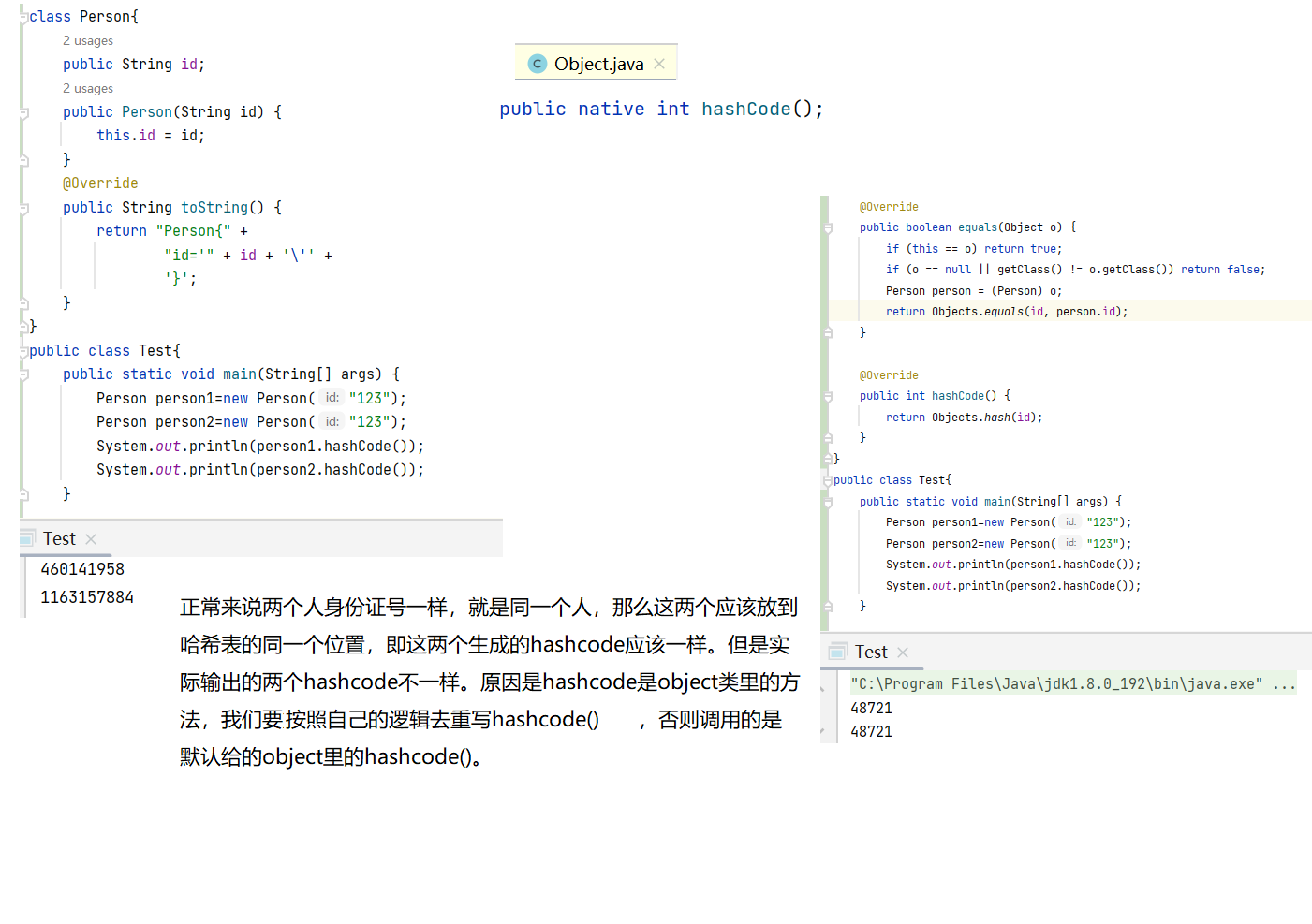

面试问题2:
两个对象的hashcode一样,equals一定一样吗?
两个对象的equals一样,hashcode一定一样吗?
答:不一定,一定。(hashcode一样说明这两个对象在同一个Index,而哈希表是数组+链表的结构,同一个index有一个链表,不一定是同一个结点。)
(举个查字典的例子,美女和美食都在美这个字的目录底下,相当于hashcode一样,而它们不是同一个词,equals不同。如果词语内容一样,那么肯定在同一个目录底下,hashcode肯定一样)

HashMap源码分析
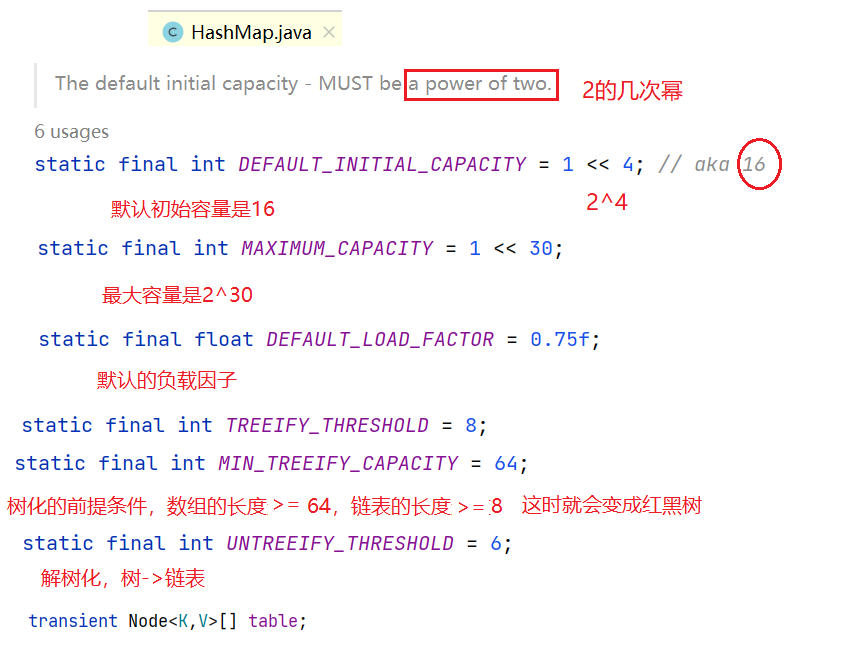
构造方法:
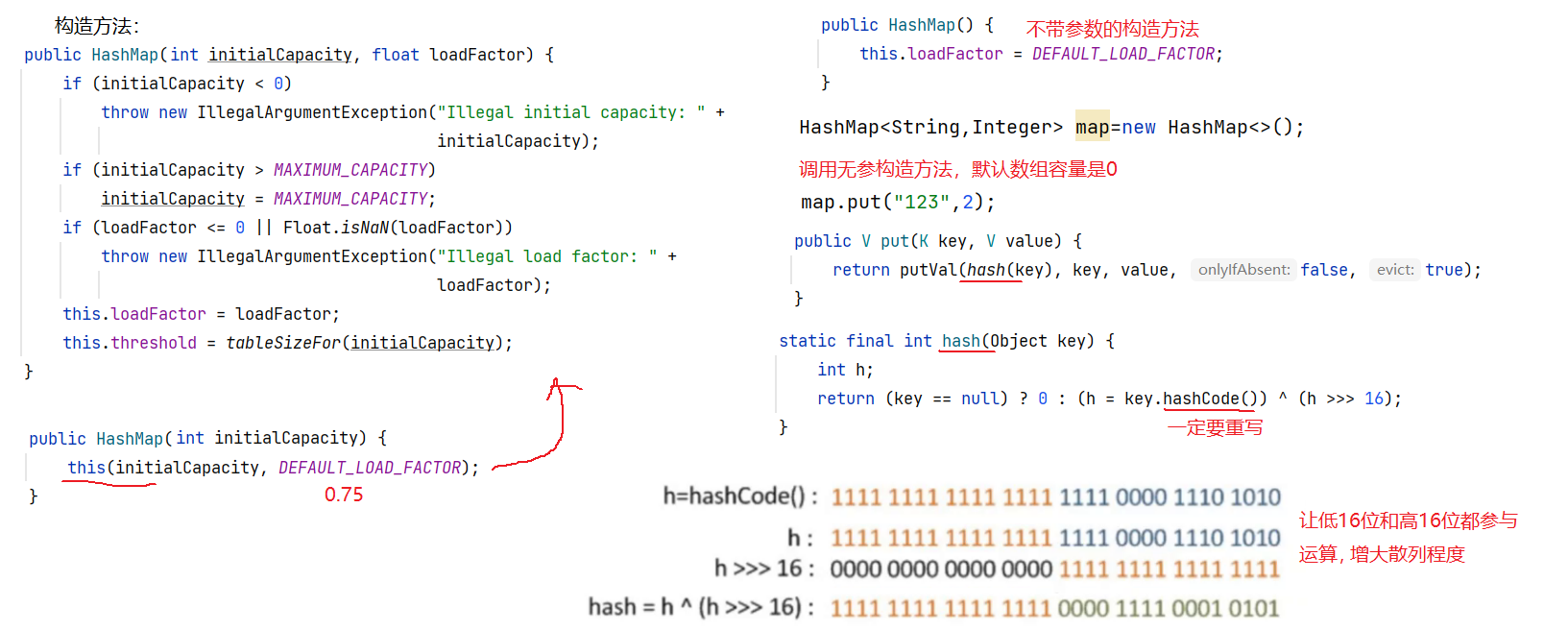
关于让低16位和高16位异或这一点可以参考这篇文章:
https://zhuanlan.zhihu.com/p/458305988
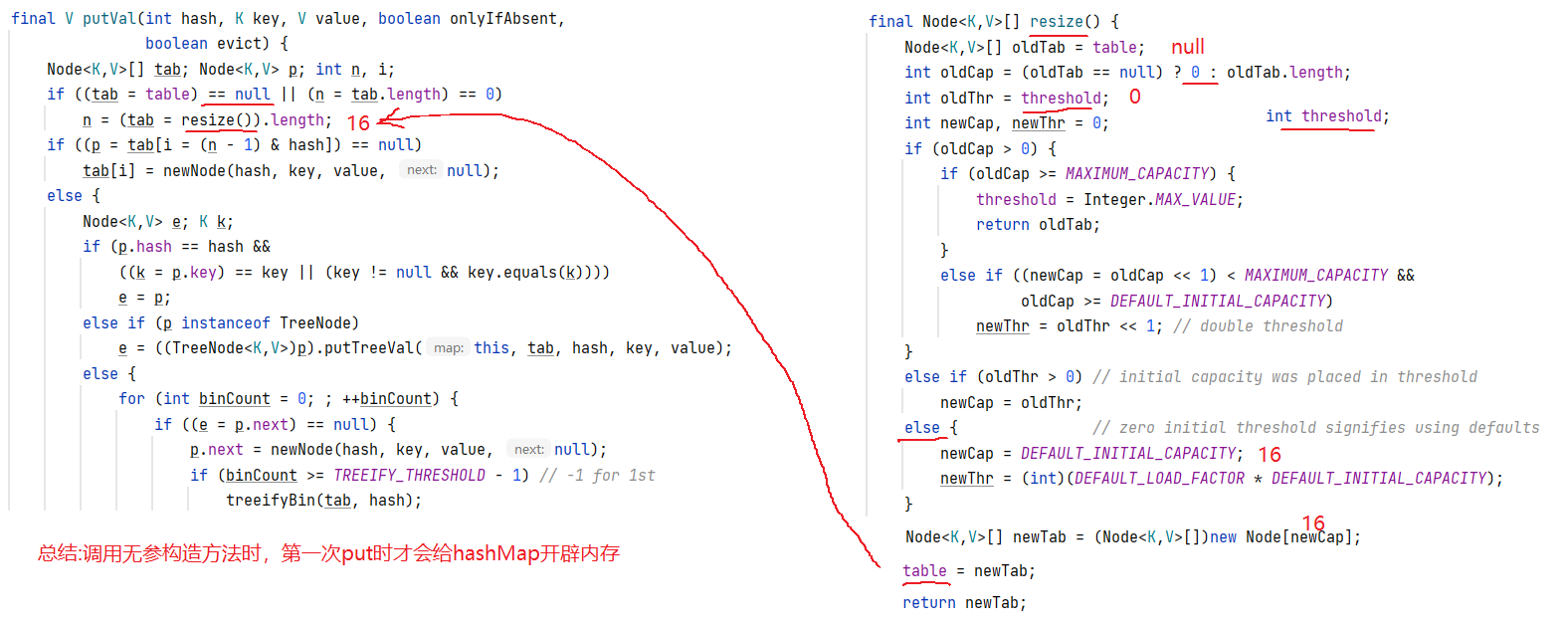
面试问题1:
调用无参构造方法时什么时候给hashMap分配内存?
答:第一次putVal时
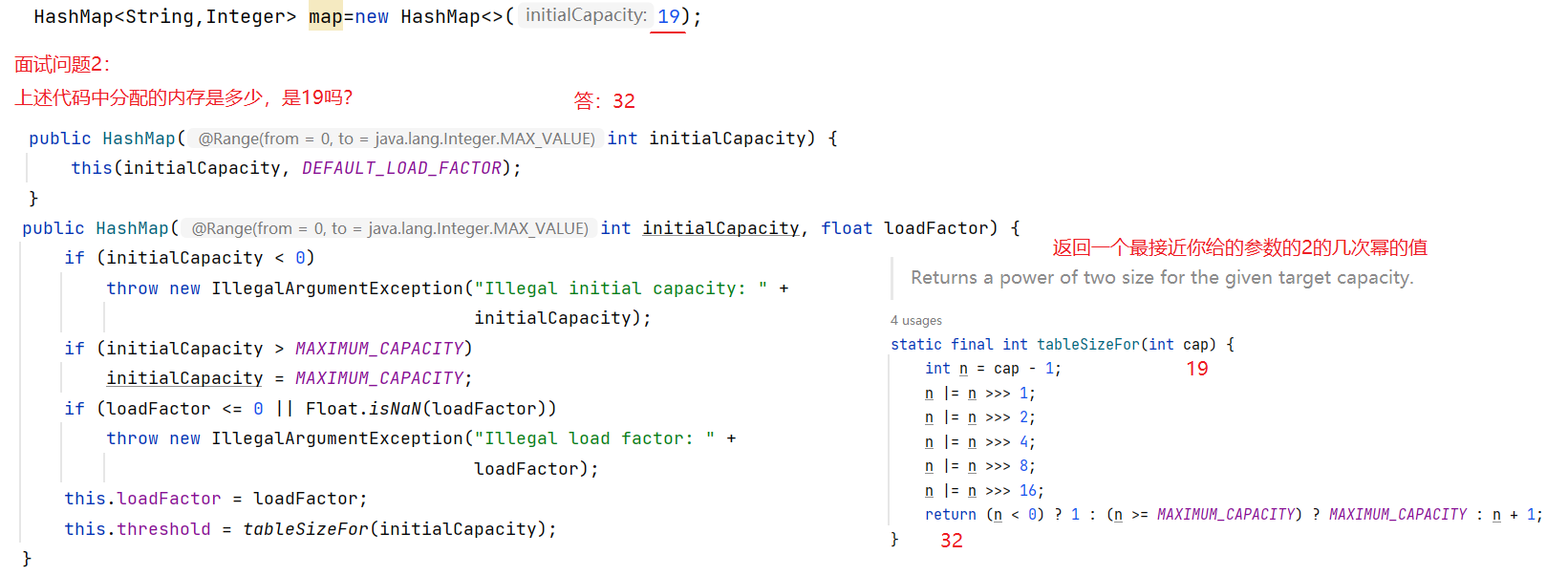
问题:HashMap不要求放在里面的元素可比较(没有实现比较器),而红黑树是二叉搜索树,左边<根<右边。上面介绍了当HashMap的数组长度>=64&&链表长度>=8时会树化。这中间是怎么操作的?
